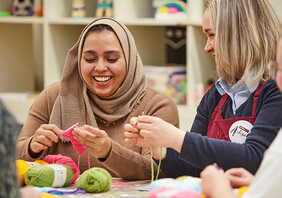6 Fluid Art Pouring Techniques to Try
If you're looking to get started in fluid art pouring, then this beginner friendly guide is just for you! Not only will you be able to discover the abstract methods of fluid art paint pouring, but you'll be able to create 6 beautiful and mesmerising artworks which will transform any interior space!
Get to grips with the basics of fluid art by discovering 6 fun paint pouring techniques in this project guide.
Project and instructions by Jenny Muncaster.
You will need
How to make
You will also need:
* A butane gas torch
Place your canvas on supports in a tray to catch any drips. Add layers of the pre-prepared paints in an empty cup starting with white. Alternate paint colors in differing amounts. Colors added to the cup do not have to be in a particular order, although the addition of white in-between colors increases the likelihood of cell production. As white is denser, the colors pop through when the cup is flipped.
Holding the cup and canvas together flip both over so the cup is now upside down on top of the canvas. Allow the cup of paint to settle for a few moments. Lift the cup and allow the paint to fill the canvas surface.
To create additional cells, use a butane gas torch to heat areas of the paint. Cells will spontaneously erupt in areas where the butane torch is used. Then, tilt the canvas to cover completely and stretch the cells.
Allow 48 hours drying time. If desired, dry finished artwork can then be varnished using the pouring medium to add a glossy finish.






Place the strainer in the middle of the canvas. Start off pouring premixed white paint into the strainer until you see it flowing out of the holes on to the canvas.
Alternate pouring paint colours into the strainer. Colours do not have to be added in a particular order however I have found contrasting colours make most impact. As the colour flows out of the strainer you will have a wonderful pattern.
When happy with the results, slightly twist and lift the strainer up & catch any drips with your hand while removing from the canvas.
Tip: Try tilting your canvas for further effect.
Allow 48 hours drying time.






Place your canvas on supports in a tray to catch any drips. Add layers of the pre-prepared paints in an empty cup. Alternate paint colours in differing amounts. When layering the paints in the cup remember the first colour in will be the last colour poured out.
Start pouring the layered paint from the cup on to the canvas. Starting from the centre, slightly swirl the cup as you pour. This swirling motion will encourage the 'tree ring' effect in the paint as it moves out and covers the canvas. Then, tilt the canvas until you are happy with the placement.
To create additional cells, use a butane gas torch to gently heat areas of the paint. Cells will spontaneously erupt in areas where the butane torch is used.
Allow 48 hours drying time.






Starting in one corner (a couple of centimetres in), slowly pour blue paint from one end to the other in a zig zag stripe effect. Continue pouring blue and green in alternating stripes directly on to the canvas in between and on top.
Pour a strip of white paint horizontally across the top of the canvas in the gap you have left.
Slowly pull a palette knife (or a piece of acetate/old credit card) across the canvas dragging the white paint over the other colours. Wait for the cells to appear.
To create additional cells, use a butane gas torch.
Allow 48 hours drying time.






Experiment with making artwork from all the excess acrylic paint drips from your pouring and tilting which have collected in the bottom of the tray. Simply take a canvas or board, flip it over and dip in the excess paint.
Lift up and flip it back to reveal a unique pattern.
To create additional cells, use a butane gas torch to gently heat areas of the paint. Cells will spontaneously erupt in areas where the butane torch is used.
Allow 48 hours drying time.




Wooden Craft shapes make fantastic surfaces to decorate with acrylic pouring. These can be quite small, so a plastic shot glass makes a perfect size container for a 'dirty flip' pour.
Place your craft shape on the rack in a tray to catch any drips. Add layers of the pre-prepared paints into the shot glass starting with white. Alternate paint colours in differing amounts.
Place the wooden craft shape over the shot glass and flip both over so the shot glass is now upside down on top of the heart shape. Allow the cup of paint to settle for a few moments. Then, lift the shot glass and allow the paint to fill the surface.
To create additional cells, use a butane gas torch to heat areas of the paint. Cells will spontaneously erupt in areas where the butane torch is used.
Allow 48 hours drying time.





















